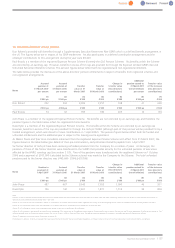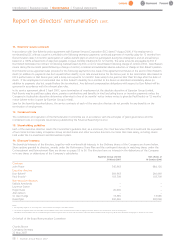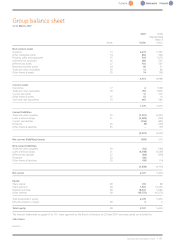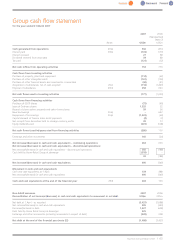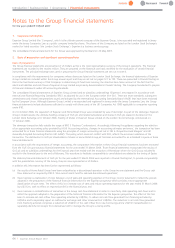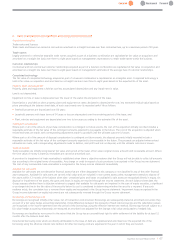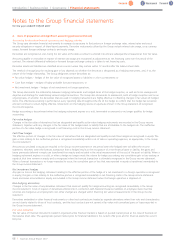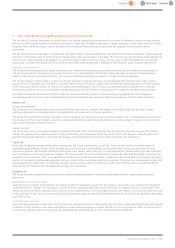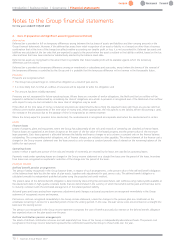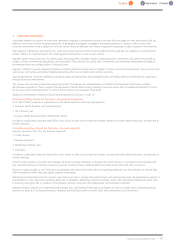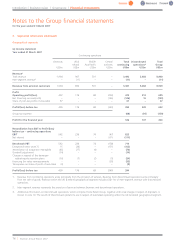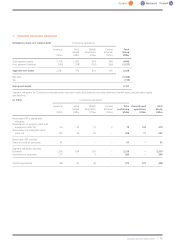Experian 2007 Annual Report Download - page 67
Download and view the complete annual report
Please find page 67 of the 2007 Experian annual report below. You can navigate through the pages in the report by either clicking on the pages listed below, or by using the keyword search tool below to find specific information within the annual report.
Experian Annual Report2007 |65
2. Basis of preparation and significant accounting policies (continued)
Significant accounting policies
The principal accounting policies applied in the preparation of these financial statements are set out below. These policies have been consistently
applied to both years presented, unless otherwise stated.
Basis of consolidation
Subsidiaries
Subsidiaries are fully consolidated from the date on which control is transferred to the Group. They cease to be consolidated from the date that
the Group no longer has control. Under the requirements of IFRS 3 all business combinations are accounted for using the purchase method.
Inter-company transactions, balances and unrealised gains on transactions between group companies are eliminated on consolidation. Unrealised
losses are also eliminated unless the transaction provides evidence of an impairment of the asset transferred.
Accounting policies of subsidiaries are consistent with the policies adopted by the Group for the purposes of the Group’s consolidation. The
consolidated financial statements incorporate the financial statements of the Company and its subsidiary undertakings for the financial year
ended 31 March 2007.
Alist of the significant investments in subsidiaries, including the name, country of incorporation and proportion of ownership interest is given in
note O to the parent company financial statements.
Associates
Associates are entities over which the Group has significant influence but not control, generally achieved by a shareholding of between 20% and
50% of the voting rights. The equity method is used to account for investments in associates and investments are initially recognised at cost.
The Group’s share of net assets of its associates and loans made to associates are included in the Group balance sheet. The Group’s share of its
associates’ post-acquisition after tax profits or losses is recognised in the Group income statement, and its share of post-acquisition movements in
equity is recognised in the Group’s equity. The cumulative post-acquisition movements are adjusted against the carrying amount of the
investment. The carrying amount of an investment in an associate is tested for impairment by comparing its recoverable amount to its carrying
amount whenever there is an indication that the investment may be impaired.
Revenue recognition
Revenue represents the fair value of the sale of goods and services to external customers, net of value added tax and other sales taxes, rebates
and discounts, including the provision and processing of data, subscriptions to services, software and database customisation and development
and the sale of software licences, maintenance and related consulting services.
Revenue in respect of the provision and processing of data is recognised in the year in which the service is provided. Subscription revenues, and
revenues in respect of services to be provided by an indeterminate number of acts over a specified period of time, are recognised on a straight
line basis over those periods. Customisation, development and consulting revenues are recognised by reference to the stage of completion of the
work. Revenue from software licences is recognised upon delivery. Revenue from maintenance agreements is recognised on a straight line basis
over the term of the maintenance period.
Where a single arrangement comprises a number of individual elements which are capable of operating independently of one another, the total
revenues are allocated amongst the individual elements based on an estimate of the fair value of each element. Where the elements are not
capable of operating independently, or reasonable measures of fair value for each element are not available, total revenues are recognised on a
straight line basis over the Ncontract period.
Foreign currency translation
Presentation currency
The Group’s financial statements are presented in US Dollars.
Transactions and balances
Transactions in foreign currencies are recorded in the functional currency of the relevant Group entity at the exchange rate prevailing on the date
of the transaction. At each balance sheet date, monetary assets and liabilities denominated in foreign currencies are retranslated at the exchange
rate prevailing at the balance sheet date. Translation differences on monetary items are taken to net financing costs in the Group income
statement except when deferred in equity, as qualifying net investment hedges or cash flow hedges.
Translation differences on non-monetary available for sale financial instruments are reported as part of the fair value gain or loss in equity.
Group undertakings
The results and financial position of Group undertakings whose functional currencies are not US Dollars are translated into US Dollars as follows:
•Assets and liabilities aretranslated at the closing rate at the balance sheet date;
•Income and expenses are translated at the average exchange rate for the year (unless this average is not a reasonable approximation of the
cumulative effect of the rates prevailing on the transaction dates, in which case income and expenses aretranslated at the rate on the dates of
the transactions); and
•All resulting exchange differences are recognised as a separate component of equity.




